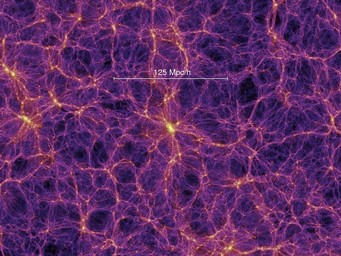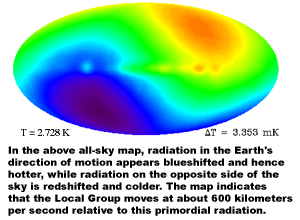

Brane cosmology is directly testable both in space, both in time dimension, because it manifests both in foamy structure of dark matter, both in gradient of space-time expansion, i.e. by the Doppler anisotropy of cosmic microwave background radiation (CMB). From time perspective we should observe a change of gravity constant with time, because observable portion of Universe passes through more and more dense Aether gradually (we can interpret it like fall into giant black hole). This behavior leads to new interpretation of classical theory of expanding Earth, but it can be tested in even more straightforward ways.

Because observable matter has a greater density, then the vacuum, we can consider it as a pieces of pre-collapsed Aether foam. During space-time deforms, these peaces would behave like more stiff and the density difference between Aether foam forming matter and vacuum will cease to zero. Because the gravity force and gravity constant depends on this density difference, it will decrease too with time. We can even observe it in real time for example by gradual decrease of mass of kilogram prototype - as it virtually dissolves in collapsing vacuum (compare the proton decay, as predicted by Standard model).

We should realize, we cannot detect the change in light speed in expanding space-time, until we use measure based on standing waves of light (i.e. laser resonator in contemporary SI system of units) for meter definition. But when we use a solid rod as a reference measure, we could detect change of light speed related to this measure - after then the gravity constant would remain constant, just the light speed will change - so we shouldn't detect any change in fine structure constant anyway. By some theorists change in speed of light is interpreted as a disappearance of time from our Universe, but such interpretation is apparently dual to variable light speed concept and/or accelerated space-rip, as interpreted by other cosmologists.

The more dense vacuum is, the less stable are all material objects in it, the smaller amount matter is sufficient for phase transition of stellar mass. Therefore the decrease of gravity constant is followed by gradual decrease of luminosity of periodic flashes of type Ia supernovae cefeids (so called the standard candles), which would appear more remote and frequent, then those in constant gravity field. From this perspective the speed of Universe expansion would remain constant (i.e. no dark energy should be required) - just the gravity constant or speed of light will change. These insights render our Universe a much more dynamic, then we ever expected before - but we should realize, they're plural and as such they shouldn't be mixed mutually.


The annual motion of Earth in Aether density gradients should manifest by subtle annual changes of gravity constant or light speed, too. This possibility was opened recently and it can be tested easily by correlation of annual changes in gravity constant to spatial orientation toward Virgo cluster and Rubin-Ford anisotropy.

More dense vacuum in direction to Virgo cluster should increase the speed of heavy element decay, because it weakens all attractive forces, not just the gravity. This annual change in decay rate of heavy elements was observed recently at the case of Si-32 and Ra-226 elements, which was correlated to Earth-Sun distance and possibly the catalysis of decay by solar neutrino flux. Again, the correlation of these observations with CMB anisotropy can help us decide, which explanation is more relevant here. As we can see, even quite rough logical approach brings a number of testable predictions and connections here.



14 comments:
Zephir,
I think you idea about the aether may be equivalent with the Dirac sea, which is a consequence of the Dirac equation. This equation is like the Schrödinger equation but with Lorentz symmetry.
According to wikipedia :
“Dirac, Einstein and others recognised that it is related to the 'metaphysical' aether [1]:
... with the new theory of electrodynamics we are rather forced to have an aether.
– P.A.M. Dirac, ‘Is There An Aether?,’ Nature, v.168, 1951, p.906.
(...)
Despite its success, the idea of the Dirac sea tends not to strike people as very elegant.“
As you can see, the idea of the aether, although many times has been a successfull idea, doesn't like to the theoretical physics community.
El Cid,
Aether of AWT is a Boltzmann gas of infinite mass/energy density. As such it isn't a consequence of the Dirac's equation and isn't equivalent of Dirac's sea - for example it doesn't consider antiparticles as a "holes" of Aether. Such antiparticles would have a negative rest mass, i.e. they would be a tachyons.
But you're right, theorists don't like an Aether concept, because they tend to easily predictable solutions. Multiparticle systems are difficult to handle by formal math.
Could AWT be modelled by an ideal gas? Namely is this gas described by the equation PV=nRT?
How much is n for the aether that filled the Universe?
Indeed - but state equation of ideal gas is valid only for sparse ideal gas, where the free average path of density fluctuations is negligible with compare to their size (i.e. energy density >> mass density).
Whereas in Aether mass density ≈ energy density - at least for vacuum phase, because we can see only density gradients in it. Such equilibrium corresponds condensing supercritical fluid with foamy density fluctuations - rather then ideal gas under terrestrial conditions.
The above doesn't say, Aether isn't such ideal gas - but we tend to ignore its indeterministic portion, so Aether appears a much more close to supercritical state, then it really may be.
The N constant depends on molar mass, which is arbitrary number, depending on what we we consider as a fundamental particles of Aether.
BLABLA...Zeph & El Cid HAHA
Zephir,
The problem could be that in an ideal gas the density is constant, because it's a system in thermodynamic equilibrium. As the density is constant, its gradient is zero. I think if the aether can be modelled like an ideal gas, then the matter couldn't arise from the density gradient of the aether, could it?. If I'm writing nonsenses, sorry, but my knowledge of the AWT is rather sparse.
Anonymous,
sorry but, BLABLABLABLA could be useful information, because AWT could be a very good idea. Don't discard the AWT, until you have proven that the theory is wrong, thanks.
And if the matter doesn't arise then the gravity doesn't change. In this case, the Universe would be a dense ideal gas, but as, this gas would be in thermodynamic equilibrium then it's static and the time wouldn't exist. As the time wouldn't exist, we can model the universe with only three dimension, and the special relativity is not necessary, neither. Moreover, if the aether has got a density constant, we only need a one dimension to describe the Universe because the three dimensions would be identical, one with the others, don't they?
/..an ideal gas the density is constant.../
Only macroscopically, from this the uniformity of Universe follows. At sufficiently local level the density fluctuations of ideal gas follow Maxwell-Boltzmann distribution, the temperature fluctuations as well.
The decision, how "local" this scope should be depends solely on density of gas. In very dense gas, the random density fluctuations will become deep, multidimensional and pretty large with respect of more subtle/shallow fluctuations.
Now, I think I see it clear. One thing is the macroscopic physics, which deal with averaged quantities, and other thing is the microscopic physics, which deal with the fluctuations of the averaged quantities. Sorry for my ignorance. Maybe one prediction of the AWT is that the dimensions of the space arise due to the density fluctuations of the aether, namely, due to the density gradient of the aether.
One thing more to say. It seems to me, that you use the classical statistical distribution, i.e. Maxwell-Boltzmann distribution, to describe the macroscopic behaviour of the aether, instead of using quantum statistical distributions, like Fermi-Dirac distribution or Bose-Einstein distribution. why? Do you think the classical physics could be more fundamental than quantum mechanics, as Einstein dreamt?
/* ..do you think the classical physics could be more fundamental than quantum mechanics, as Einstein dreamt...*/
We cannot built up a fundamental description of reality on equations and postulates, which we don't understand in full depth.
Only behavior of abstract system of coliding particles is fully predictable from its very beginning and it doesn't need to be verified in experiments.
/*..the dimensions of the space arise due to the density fluctuations of the aether..*/ Of course, by AWT the number of dimensions of our space-time follows from compactness of 3D kissing hyperspheres arrangement.
/*..sorry for my ignorance...*/
No problemo... But your case illustrates clearly, people have certain problem to adopt AWT ideas even at the moment, when they're quite opened to them. Not saying about situation, when they hostile, because they promote alternative TOEs, for example.
For me it's somewhat surprising, why people even after two thousands years of Aether concept existence have problem to consider, Aether is very dense gas forming the vacuum. How else the light could spread through it in large energy density, for example?
In my opinion, every physicist should consider this idea at the first place, because it's most natural model from everything, what we know about Nature.
Zeph don`t be a fool !!
Why not - I like it?
Fools are simple people, who can comprehend trivial things only - whereas fundamental concepts are supposed to be simple. Therefore fools are forced to think in Occam's razor way authomatically.
The common problem of experts is (between others), their thinking is naturally divergent, as they tend to stuck in various details and complexities of their models - so they cannot see a forest through the woods.
Try to imagine, you're finding your way in fractal landscape - the thorough approach based on deep analysis of all details isn't apparently the best approach here.
Post a Comment